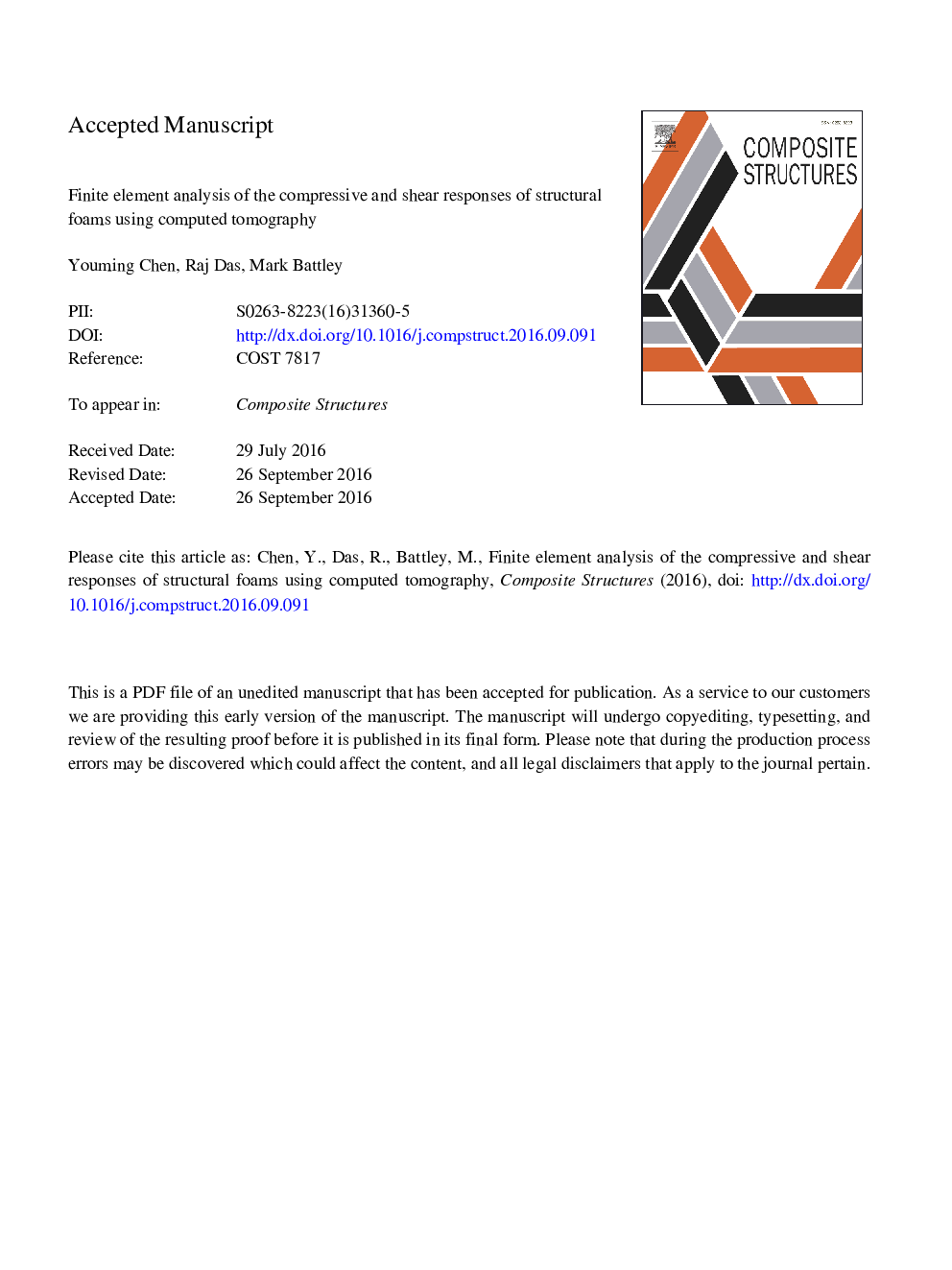| کد مقاله | کد نشریه | سال انتشار | مقاله انگلیسی | نسخه تمام متن |
|---|---|---|---|---|
| 4917954 | 1428548 | 2017 | 37 صفحه PDF | دانلود رایگان |
عنوان انگلیسی مقاله ISI
Finite element analysis of the compressive and shear responses of structural foams using computed tomography
ترجمه فارسی عنوان
تجزیه و تحلیل عنصر محدودی از پاسخ فشاری و برش فوم ساختاری با استفاده از توموگرافی کامپیوتری
دانلود مقاله + سفارش ترجمه
دانلود مقاله ISI انگلیسی
رایگان برای ایرانیان
کلمات کلیدی
مدل عنصر محدود توموگرافی کامپیوتری، فوم بسته به سلول، فشرده سازی و برش، مکانیسم شکست خم شدن و رسیدن،
ترجمه چکیده
هدف از این مقاله ایجاد یک چارچوب برای مدل سازی عناصر محدود از پاسخهای فشاری و برشی فومهای بسته با استفاده از تصاویر کامپیوتری توموگرافی و کشف مکانیزمهای تغییر شکل و شکست در سطح سلول در فوم بسته های تحت فشار و برش است. نتایج نشان می دهد که مسطح چهار تایی چهار ضلعی، در مدل سازی فوم بسته های سلولی مناسب تر از مش واکسل مکعبی است. تراکم شبکه با یک عنصر چهار عنصر درجه دوم در طول ضخامت دیواره سلولی می تواند نتایج را با دقت خوب انجام دهد. عناصر حجمی نماینده برای فوم بسته های سلولی باید شامل حداقل 5.2 سلول و 3.9 سلول در امتداد هر لبه برای تست های فشرده سازی و برش. فشرده سازی فشاری و خم شدن برش در طول رژیم الاستیکی فشرده سازی و برشی به نظر می رسد. انقباض به عنوان یک آغازگر شکست عمل می کند که حالت های تغییر شکل دیوارهای سلولی را از فشرده سازی درون هواپیما، کشش یا برش به خم شدن تغییر می دهد. انحراف بزرگ بعدی دیواره های سلولی و مواد تشکیل دهنده منجر به تخریب بیشتر در سفتی فوم های جهانی می شود. انقباض برشی باعث می شود که دیواره های سلولی ظرفیت حمل بار را در جهت مولفه فشاری بار برشی کاهش دهند، بنابراین از تخریب فشاری در کاهش ظرفیت باربری دیواره های سلولی کمتر است. در نتیجه، سختی جهانی فوم بسته های سلولی در آزمون های برشی در مقایسه با تست های فشرده سازی سریعتر کاهش می یابد. مدول یانگ از مواد پایه ی پودر، کمی بر مقاومت فوم تاثیر می گذارد. این به این دلیل است که دیواره سلولی پس از خم شدن خم می شود و حداکثر بار خمشی که دیواره های سلول های بافتی می تواند تحمل می شود، بر اساس استحکام کششی مواد پایه تعیین می شود.
موضوعات مرتبط
مهندسی و علوم پایه
سایر رشته های مهندسی
مهندسی عمران و سازه
چکیده انگلیسی
This paper aim to establish a framework for finite element modelling of the compressive and shear responses of closed-cell foams using computed tomography images, and to explore the deformation and failure mechanisms at cell level in closed-cell foams under compression and shear. Results show that quadratic tetrahedral mesh is more suited than cubic voxel mesh in modelling closed-cell foams. The mesh density with one quadratic tetrahedral element across the thickness of cell walls can yield results with good accuracy. Representative volume elements for closed-cell foams need contain at least 5.2 cells and 3.9 cells along each edge for compression and shear tests, respectively. Compressive buckling and shear buckling appear during the initial elastic regime of compression and shear, respectively. Buckling acts as a failure initiator, which changes the deformation modes of cell walls from in-plane compression, tension or shear to bending. Subsequent large deflection of cell walls and material yielding lead to further degradation in the global stiffness of foams. Shear buckling causes cell walls to lose load-carrying capacity along the direction of the compressive component of the shear load, therefore is less detrimental than compressive buckling in reducing the load-bearing capacity of cell walls. Consequently, the global stiffness of closed-cell foams degrades less rapidly in shear tests compared to compression tests. The Young's modulus of foam base materials slightly affects foam strengths. This is because cell walls undergo bending after buckling, and the maximum bending load that the buckled cell walls can bear is determined by the yield strength of base materials.
ناشر
Database: Elsevier - ScienceDirect (ساینس دایرکت)
Journal: Composite Structures - Volume 159, 1 January 2017, Pages 784-799
Journal: Composite Structures - Volume 159, 1 January 2017, Pages 784-799
نویسندگان
Youming Chen, Raj Das, Mark Battley,
